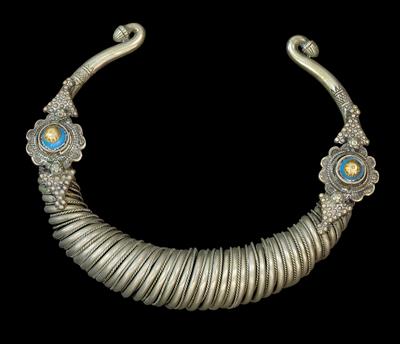Afghanistan, Nuristan: A typical spiral choker of the Kafirs (Nuristani) made of quality silver alloy and decorated with two blue glass pearls.
Afghanistan, Nuristan: A typical spiral choker of the Kafirs (Nuristani) made of quality silver alloy and decorated with two blue glass pearls.

Northeast Afghanistan and western region of North Pakistan are an old cultural and ethnological retreat, where, in spacious valleys of the Hindu Kush, lived the Kafir (‘unbeliever’) tribes. With their own languages, religion and culture. They were only (forcefully) converted to Islam in the winter of 1895/96 in a military campaign by the Afghan Shah Abdur Rahman. And it was only then that their lands, difficult to access, were renamed Nuristan (‘Land of heavenly Light’). Remaining Kafiristani tribes (the Kalash) could only preserve their old culture in pockets in Northwest Pakistan, around Chitral. The present spiral-choker typifies ornaments from the old ‘Kafir’ culture. It consists of a thick silver spiral and another one made of thin, twisted silver wire wrapped around the first. On both sides, these spirals end in an even, round, cast and partly engraved projections with ends resembling bent buds. Glued with brown tree resin atop the places where the two spirals are soldered together at the two ends are silver appliqués. Fixed by silver plates within the round rosettes of the appliqués are two big and pierced blue glass pearls. It is thought that this type of choker was originally made in the Swat Valley in North Pakistan and brought westwards to the Kafirs in Afghanistan with trade. A great specialist in Afghan culture, Dr. Alfred Janata, in his book ‘Schmuck in Afghanistan’ [Afghan Jewelry] writes: ‘The production of these chokers must have shifted around or shortly after 1900, as, in pre-Islamic Kafiristan, they were symbols worn only by high-ranking men, their women and daughters.’ H: 16 cm, W: c. 20 cm. 19th century to around 1900. (ME)
Provenance: German Private Collection.
Lit.: 'Schmuck in Afghanistan' by Alfred Janata, ill. 30.
Expert: Prof. Erwin Melchardt
 Prof. Erwin Melchardt
Prof. Erwin Melchardt
+43-1-515 60-465
erwin.melchardt@dorotheum.at
02.11.2015 - 14:00
- Dosažená cena: **
-
EUR 625,-
- Vyvolávací cena:
-
EUR 300,-
Afghanistan, Nuristan: A typical spiral choker of the Kafirs (Nuristani) made of quality silver alloy and decorated with two blue glass pearls.
Northeast Afghanistan and western region of North Pakistan are an old cultural and ethnological retreat, where, in spacious valleys of the Hindu Kush, lived the Kafir (‘unbeliever’) tribes. With their own languages, religion and culture. They were only (forcefully) converted to Islam in the winter of 1895/96 in a military campaign by the Afghan Shah Abdur Rahman. And it was only then that their lands, difficult to access, were renamed Nuristan (‘Land of heavenly Light’). Remaining Kafiristani tribes (the Kalash) could only preserve their old culture in pockets in Northwest Pakistan, around Chitral. The present spiral-choker typifies ornaments from the old ‘Kafir’ culture. It consists of a thick silver spiral and another one made of thin, twisted silver wire wrapped around the first. On both sides, these spirals end in an even, round, cast and partly engraved projections with ends resembling bent buds. Glued with brown tree resin atop the places where the two spirals are soldered together at the two ends are silver appliqués. Fixed by silver plates within the round rosettes of the appliqués are two big and pierced blue glass pearls. It is thought that this type of choker was originally made in the Swat Valley in North Pakistan and brought westwards to the Kafirs in Afghanistan with trade. A great specialist in Afghan culture, Dr. Alfred Janata, in his book ‘Schmuck in Afghanistan’ [Afghan Jewelry] writes: ‘The production of these chokers must have shifted around or shortly after 1900, as, in pre-Islamic Kafiristan, they were symbols worn only by high-ranking men, their women and daughters.’ H: 16 cm, W: c. 20 cm. 19th century to around 1900. (ME)
Provenance: German Private Collection.
Lit.: 'Schmuck in Afghanistan' by Alfred Janata, ill. 30.
Expert: Prof. Erwin Melchardt
 Prof. Erwin Melchardt
Prof. Erwin Melchardt
+43-1-515 60-465
erwin.melchardt@dorotheum.at
|
Horká linka kupujících
Po-Pá: 10.00 - 17.00
kundendienst@dorotheum.at +43 1 515 60 200 |
| Aukce: | Mimoevropské a domorodé umění |
| Typ aukce: | Salónní aukce |
| Datum: | 02.11.2015 - 14:00 |
| Místo konání aukce: | Wien | Palais Dorotheum |
| Prohlídka: | 28.10. - 02.11.2015 |
** Kupní cena vč. poplatku kupujícího a DPH
Není již možné podávat příkazy ke koupi přes internet. Aukce se právě připravuje resp. byla již uskutečněna.
